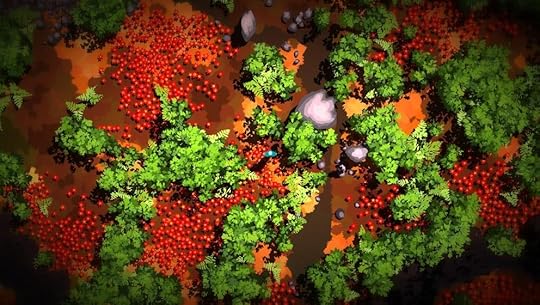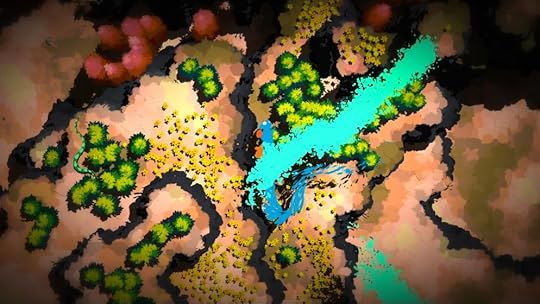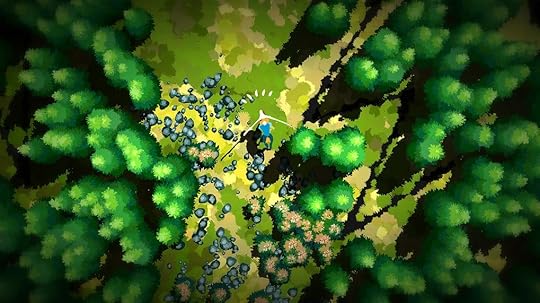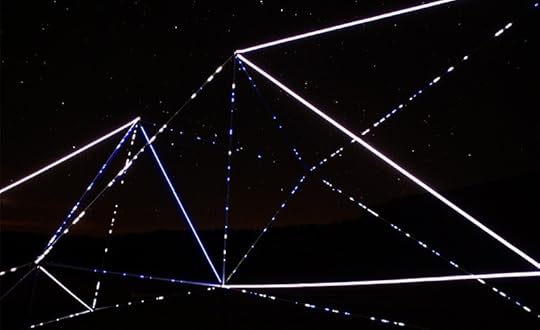Kill Screen Magazine's Blog, page 195
November 13, 2015
Future Unfolding will let us play with the animals on PS4, and so it should
"Come, bunnies," I announced to the empty room behind me. "Follow me, your glorious leader!" In Future Unfolding, you run around a forest that has the florid appearance of spilled paint, and you can talk to the animals. As if some glorified Pied Piper, you stride with great bounds across flower patches, painting blue streaks as you sprint between the shadows of leafy trees, a fleet of fluffy animals in tow.
When I started playing Future Unfolding, my controller was disconnected, and so I was left to use either my mouse or my keyboard. "Nah," I said, and got up to plug my controller in. This is a game you want to lean back in your seat for and not hunch over the flat angle of a desk. You'll want to let it wash over you, not study it. The colors, the flora, the adoring animals; they invite you to chill the heck out.
everything is overwhelmingly bold and beaming
This is why it makes a whole lot of sense that the creators of Future Unfolding at Spaces of Play have announced that they're bringing it to PlayStation 4. It deserves to be on a console, which is intrinsically a couch experience (at least for me), and not confined to the ergonomic severity of a PC setup. Please adopt the lounge position, make yourself comfortable, and enjoy the ride.
And, yeah, it is a kind of ride. An exploration game to be specific, played somewhat unusually (for a genre increasingly dominated by the first-person perspective) from a top-down angle, but it works. You get to appreciate the procedurally generated forest that you wander from the eyes of a bumblebee seeking out the prettiest flower. As it goes, everything is overwhelmingly bold and beaming: the greens, the yellows, the reds, the blues.
But this isn't Proteus as much as it may bump shoulders with it. Sure there are monuments to seek out, secrets to unravel, and yes you can travel to different places through a swirling ritual. But there are otherworldly beasts here that don't appreciate your company. Jump on a deer and it will guide your way. Charm a bunny and it'll follow you to the ends of the earth. The amber lions (or wolves) with the spiky white manes, though? Oh, steer clear. Disturb their slumber and they divide their bodies into great numbers in order to overwhelm their prey—you.
These beasts aren't as distressing as they sound and they don't take away from the seductive magic of the experience. It provides a spike of thrill and danger, the soundtrack turning from yawning strings to aggressive rumbles to wake you the hell up. You learn to adapt to whatever this mysterious forest serves you up, such as the snakes that shoot jets of corrosive paint at you, but can also be used to clear a dense collection of trees to find hidden grottoes. Nothing you face becomes particularly stressful as time and place seems to blend more and more with each transition. "Sometimes you die," one curled up wolf told me. Death is a matter of fact here, another state in a lifetime spent inside an ever-changing forest.
You can find out more about Future Unfolding on its website. It'll be coming to PC and PlayStation 4 in 2016.



Maybe we don't need a game with Donald Trump as a pi��ata after all
Missing a punchline.
Stand aside, Waze: Mapkin is a GPS app that gives directions like a local
Mapkin is a free GPS app that gives you directions like a local, tailoring your route with hints and suggestions submitted by drivers who have driven it before.
While on the road, drivers can record messages reporting obstacles or landmarks such as, “Take a left at the light onto Main Street, just past the gas station,” or “The road is really curvy up ahead, so take it slow,” as listed by the app’s website. All driver-submitted tips are then listened to, verified and utilized in the route directions by the Mapkin team.
“We use a variety of tools including map data, satellite data, and other visual based resources to ensure tips are helpful and accurate for drivers,” said Mapkin co-creator and chief executive, Marc Regan. “ We also depend on our active and passionate community to provide tips on directions that can be improved.”

The idea behind the product is supplying an experience that more closely resembles face-to-face directions, Reagan said.
“We believe this is the next big opportunity in navigation—creating a safer, less stressful, more natural driving experience,” wrote Regan on the app’s post on Product Hunt, a site for bringing attention to the new products and tech. “When you’re driving with Mapkin, you’re hearing a mix of high visibility landmarks, local tips, and street names that more closely resembles the way a person sitting next to you would give directions.”
Other features of the app include a copilot voice that checks in after long stretches of the road and will even call you by name, turn-on-turn voice guidance with visual cues so you can stay focused on the road, and optimized routes based on real-time traffic in the area.
"Creating a safer, less stressful, more natural driving experience"
"One of the trickier problems was designing what exactly the GPS should say along the route. What is the right thing to say at the right time? We spent tons of time in cars driving around with people recording how they give directions,” Regan said, adding, “We actually looked at a few video game dialog engines for inspiration on how to build our narration engine.”
Mapkin has maintained an average of 4.5 stars through over a hundred ratings on the App Store since its launch on Sept. 16, and was featured by Apple as one of the Best New Apps on the App Store.
You can download Mapkin for free on the the App Store.
Update 11/13/15: Quotes from Marc Regan were added to this piece after publication.
Nintendo still won't make Link a girl, but they'll put him in a dress and call him Linkle
Linkle, meet Ms. Pac-Man, you might know each other.
Dive Another Way is the most fun way to break your phone
When it comes to the summer olympic sports, diving might not be the first event that gets your heart pumping. After all, those incredible gymnasts have all those fancy, flashy costumes and the competitors in the 100 meter sprint appear to pull of super human feats. All in all, other events can simply dwarf how awesome and how much skill is required to pull off a perfect dive.
But fear not olympic divers, because videogames are here to rescue your image. In the game jam entry Dive Another Way (by Max Wrighton, Gian Dbeis, and Remy Stuurworld), two players attempt to synchronize their jump together by throwing their phones up into the air. It's a game that combines all the excitement of probably breaking your phone and the joys of ragdoll physics and brings it to the honored sport of diving! (Though the creators are careful to note that "We take no responsibility for property damages. Play at your own risk.")
The game's setup is simple (though not safe) enough. The dive countdown begins once both players are ready. After throwing their phones into the air, players are expected to catch it (which the instructions point out is an "important part of the process.") Hopefully, when all is said and done, the player will have cause to celebrate and not just cause to call their cellphone insurance company.
As the name implies, Dive Another Day really piles on the pixelated carnage. Aside from the potential murder of your cellular device, there's also a decent amount of corpses in the game after you've been at it for long enough. Every diver that makes his haphazard leap into the air, limbs flying up in a chaotic mess, must also inevitably come crashing back down to earth. After its done, his lifeless body remains floating in the gently moving water.
"We take no responsibility for property damages."
Past divers don't even disappear; the corpses just stack up on top of each other, until the divers eventually start jumping into an indistinguishable mass grave of their own fallen brethren, before becoming one themselves. It's a disturbing image, but somehow made hysterical by the ragdoll physics. Some divers don't even make it into the water. Like a hatching baby sea turtle that dashes toward the opposite direction of the ocean, these unfortunate divers flop around the diving boards without ever fulfilling their true purpose or even getting a single toe wet.
To add insult to injury, the creators decided to add the goofiest sound effect possible to score this horrifying death march to the diving board. "Splooooooosh," intones the voice of a man who can only be described as Tina Belcher's husband.
You can play Dive Another Day for free on your Android (at your own risk).
WWE 2K16 splits the difference between sports and entertainment
WWE gets the lunacy of pro wrestling, but has too much sports in its DNA.
November 12, 2015
Adam brings an unusual perspective to bleak black-and-white horror
It’s rare to see an isometric horror game. The 3/4 perspective affords more visibility than what is conducive to most horror scenarios, where the possibility of things lurking in the darkness or just around the bend helps heightens the tension.
But in Adam, at least what’s shown in its only available trailer, ceilings are cutaway to reveal the contents of other rooms, like an old RPG or adventure game. A halo of light illuminates the titular character, emphasizing the darkness around him, but we can still see. In place of the mystery another perspective might offer, Adam must find its horror elsewhere, which is part of its allure.
How will Adam use this style to its advantage? The 2009 freeware horror game Ao Oni used the 3/4 perspective to violate the safety a player feels having most of a room in view, by forcibly filling that space with its unsightly antagonist. STASIS, an isometric sci-fi horror from this past August, relied heavily on violence.
Adam doesn’t seem to fall in line with either of these. Its stark black and white calls to mind The Cat Lady and Neverending Nightmares, both side-scrolling horror games that make heavy use of shocking imagery to tell their tales. Adam's story seems to be rooted in a particular space—Adam’s home.
"His story is baked into the bricks"
Its website reads: “It is Adam's last few hours. Trapped in the bones of his house you will un-leaf Adam’s life, exploring the world through his eyes. Everything hints at Adam's past, his years have been long and path well trodden. His story is baked into the bricks. No one ever came from nothing and no one ever leaves that way.”
There are a few short blog entries about Adam on the Blind Sky Studios website, which hint at a possible Steam Greenlight sometime soon.
Learn more about Adam on its website.
The New York Times wants you to "experience" its stories with virtual reality
The New York Times has a new virtual reality offering—and no, it isn’t called Jayson Blair.
NYT VR, which launched last weekend, is a new storytelling venture or, as The Grey Lady calls it with alarming frequency, an “experience.” Using the NYT VR app, you can view (experience?) video stories with a Google Cardboard virtual reality headset or by simply moving the phone around in front of your face. The New York Times’ VR stories can also be viewed in a more traditional panoramic web video form. Something approaching VR for everyone!
The first major story to appear on NYT VR was “The Displaced,” which consists of three cross-cutting portraits of children whose lives have been disrupted by conflicts in Syria, South Sudan, and eastern Ukraine. The video is a stately affair, filmed using long, static shots wherein all the movement comes from the viewer looking around. This helps to limit the effects of VR sickness but is also stylistically pleasant. The camera doesn’t pull back quite as much or as effectively as in Abderrahmane Sissako’s Timbuktu, but at its best moments “The Displaced” pulls off a similar formal trick.
this seems like a better strategy for growing VR filmmaking
“The Displaced” is not, however, without its flaws. It subject—and subjects—are interesting, but the film itself does not present a great deal of insight into their lives. If that’s what you’re looking for, the corresponding print package is more satisfying. There is also the broader question of whether this story benefits from being told in VR. The struggles of displaced children definitely deserve to be told and merit more attention. As New York Times Magazine editor Jake Silverstein notes, “nearly 30 million children worldwide have been driven from their homes by war and persecution.” But it’s not clear that the technology is really helping to tell the story here. Maybe its novelty will bring more attention to these issues, which is a positive, but this just another entry in the already-bloated category of VR 'disaster porn'.

On a slightly more technical level, NYT VR also points to the challenge of presenting subtitles in VR. Instead of placing its subtitles to the bottom of the screen, the New York Times has anchored them to physical points in each shot, which means that you have to spin around to locate them. Whilst VR encourages you to look away from a shot's ostensible focal point, this approach to subtitles punishes you for doing so. In some cases, you should probably look where the director wants you to look, but this prescriptive approach to VR filmmaking limits the technology’s potential use.
But NYT VR isn’t really about the finer points of VR filmmaking or even about the stories it contains, at least not yet. For now, this storytelling experiment is best understood as an important step in expanding the viewership for virtual reality filmmaking. The New York Times is shipping Google Cardboard headsets to its Sunday magazines subscribers, many of whom had likely never used VR technology before. Moreover, the smartphone app is engaging enough that one can imagine a user deciding to invest an afternoon of crafting or $25 to upgrade from holding the phone in front of their face to a cardboard headset. If nothing else, this seems like a better strategy for growing VR filmmaking than having interested audiences show up at events and put on Samsung Gear VR or Oculus Rift headsets. Once a sufficiently sizable audience has been built, maybe someone will even figure out how to tell a good story in VR.
Find out more about NYT VR on its website.
New exhibit hints at a future for low-poly art outside of games
The unfortunate thing about low-poly art, the aesthetic of simple shapes and abstract images seen in games like Final Fantasy VII, is that it never got much of a chance to take off as a legitimate art style all its own. In a medium where big companies are constantly competing over realistic graphics, low-poly art has been quickly phased out for more and more detailed visuals as technology has become increasingly powerful. And while the similarly retro-born pixel art has had a resurgence with the rise of independent game development, low poly-art has yet to see the same sort of revival outside of a few exceptions. Despite the potential value of minimalistic 3D graphics, the idea of designing game characters out of jagged edges, straight lines, and rough shapes seems to have been largely left behind in the days of the Nintendo 64 and the PlayStation 1.
low-poly art has been quickly phased out
Outside of the world of games, however, artists are taking this aesthetic from their youths and using it to reshape the world around themselves. Ascent, a project from London-based art studio Nocte that went up in Verdon, France earlier this September, aimed to use smooth lines and soft light to create “a harmonious relationship between human aesthetic and natural landscape.” Consisting of a massive wireframe structure covered with 60 meters of LED strips, the installation was situated in front of a serene mountain landscape and allowed attendees to change the structure’s display using Twitter posts tagged with #neverstopexploring. The idea was to place a digital filter over the natural surroundings behind it, and so allow visitors to reframe their environment in novel ways which helped bring out the most interesting aspects of both.

The result was an interactive piece that resurrected the simple shapes of low-poly graphics to create an entirely new experience. The odd thing about games as opposed to more traditional mediums such as painting is how entire aesthetics are often considered obsolete as technology progresses. Imagine if cubism or impressionism were simply tossed aside with the invention of digital painting. Low-poly art may have untapped potential that game developers never saw because they abandoned this art style too quickly. Its resurgence in the art world, however, could indicate further exploration of this aesthetic which will allow it to go places the games that familiarized us with it never could have foreseen.
Yoshi���s Woolly World is cute, but confused
The Etsy aesthetic comes to videogames
Kill Screen Magazine's Blog
- Kill Screen Magazine's profile
- 4 followers



